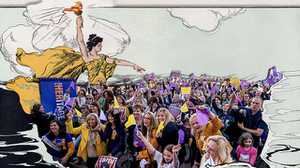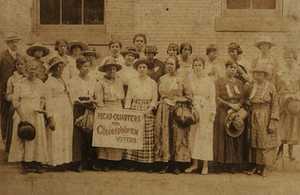From Suffrage to the Montgomery Bus Boycott, the Little-Known Club Movement that Changed a Country
Largely excluded by white suffrage leaders, Black women created a groundbreaking network that drove social and political change across the country.

This article is part of She Resisted, an interactive experience celebrating the pioneering strategies of the women’s suffrage movement.

Black women formed clubs to support their communities as early as 1793, when the Female Benevolent Society of St. Thomas was established in Philadelphia. In the coming years social organizations cropped up across the country, such as a mutual aid society founded in Rhode Island in 1809 and the Colored Female Religious and Moral Society of Salem, established in Massachusetts in 1818. What began as isolated stars on the map multiplied, over the next century, into constellations. Already by 1830, there were at least 27 Black women’s clubs just in the city of Philadelphia.
By 1914, the clubs were a vast movement aimed at giving Black women access to political power. Huge membership rolls of dedicated volunteers organized conventions, marched in parades and wrote editorials for a wide public readership. The clubs’ leaders demonstrated a sophisticated understanding of what it would take to become full and equal participants in the democratic process.

Mainstream, white-led suffrage groups afforded no platform to Black women. Existing clubs for African Americans often focused first on their male members. Instead, Black women took charge of their own futures and self-organized. They continued to collaborate with white suffragists where they were able—for example, Frances Ellen Watkins Harper addressed the 11th National Women’s Convention in 1866, and Sojourner Truth voted illegally with Susan B. Anthony to draw attention to the suffrage cause in 1872. But mainstream suffrage organizations were largely segregated, excluding Black women from membership and leadership positions.

Black women’s clubs also addressed a far greater breadth of issues than white suffrage organizations. An extensive list of social and political reforms comprised their political agenda beyond suffrage. Where either established governmental services or other progressive reformers failed to meet or even recognize African Americans’ needs, Black women's groups stepped in to assist their own communities. From creating schools for Black students and forming professional training programs, to establishing elder care and providing medical resources where white hospitals refused to serve Black patients, there was essentially no aspect of life their work did not touch.
Black women also took on policy issues, such as domestic violence, lynching and rape, that their white suffragist counterparts largely ignored. Even the fight for women’s suffrage was itself more broadly conceived by Black female activists. They understood the vote as a means to enact these more expansive reforms, and they saw that securing the vote for African American men as well as for themselves was central to these aims.

In 1896, many Black women’s clubs came together under the banner of the National Association of Colored Women (NACW), whose motto “Lifting as we climb” was a poetic distillation of the clubs’ mission—to raise the standard of life for the African American community. By 1914, NACW listed 50,000 members in over one thousand clubs, themselves organized into 28 federations. Other groups, such as church associations, African American branches of the YWCA and college alumnae groups weren’t even counted among this number. NACW also became a formidable national suffrage organization in its own right.
The Black women’s club movement preceded woman’s suffrage by more than a century and continued long after the 1920 ratification of the 19th Amendment. Ultimately, the clubs planted the seeds of the Civil Rights Movement. They ensured the education of the generation that came of age with the intensified push for civil rights. Club women also directly organized and participated in civil rights movement activism, themselves. For example, the Woman’s Political Council of Montgomery, a local Black women’s club, was the initial organizer of that city’s bus boycott in 1955. Mary Church Terrell, NACW’s first president, picketed the White House with suffragists in 1917 and went on later to lead efforts to desegregate Washington, D.C. restaurants in the 1950s. Her lifelong dedication to the fight for black liberation exemplifies the power and perseverance of the club movement in improving all aspects of African American life.








